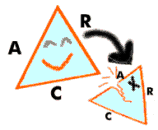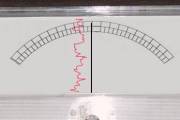Home Search Level 0 Level 1 Level 2 Level 3 Level 4 Level 4Pro Level 5 C/Sing Solo
| Tech terms | Scales | Axioms | Drills | Checksheets | Processes | Prep. lists | C/S terms | C/S tool | Grades | Cramm | Points | KTW | Online |
|
Home Search Level 0 Level 1 Level 2 Level 3 Level 4 Level 4Pro Level 5 C/Sing Solo |
|
|
| Tech terms | Scales | Axioms | Drills | Checksheets | Processes | Prep. lists | C/S terms | C/S tool | Grades | Cramm | Points | KTW | Online | |
What is an ARC Break
Definition:
A-R-C BREAK: "A sudden drop or cutting of one's Affinity, Reality or Communication with someone or something."
An ARC break is in common language known as an upset or a
condition of being shocked, disappointed, surprised, etc. The reason it is called
an A-R-C break is, that it gives an inside look and the anatomy of what is going
on. By using the name A-R-C break we have included some important data about the
mechanism. In a dictionary, including slang, you can probably find hundreds of
terms used to describe this. Omitting the slang we can here add, getting angry
at somebody, blow up, getting offended, saddened, breaking one's heart, etc., etc. In other words these are very
well known phenomena. We all know them from countless situations. We see it
happen to others and we get subject to it ourselves. the simple act of defining
it as A-R-C- breaks suddenly opens the door to do something about it.
 |
For an ARC break to happen, |
 |
First, for an ARC break to happen there must have been some ARC in the first place. The more ARC there was the greater the ARC break can get. This is seen in divorce courts on a daily basis. The saying is, "Hell hath no fury like a woman scorned". A woman betrayed by her husband can raise hell on him. The woman wouldn't do this to a complete stranger. It was the tremendous ARC that was built up during their marriage that laid the groundwork for this. Without that prior ARC there wouldn't be an ARC break. Family feuds among siblings is another example of this - starting with Cain and Able.
| Big Example: You could see the conflict of the Middle East as an ARC break. You have two populations, Arabs and Jews, in Israel. They both love the land. There was a break in Reality following World War Two when the British and the French cut out a new map for Arabia and, supported by UN, set up the Palestine Territory and later the State of Israel. For one thing, the British (and especially the British officer Lawrence of Arabia) had promised the Arabs the land after they in World War One defeated the Turkish who ruled the land. Endless confrontations and fights are now going on between the Jews and the Palestinians apparently with no end in sight. Diplomacy seems the method of choice in handling ARC breaks in a political scene and even in a social setting. But diplomacy, as being polite and underhanded, does nothing in terms of finding the correct BPC and indicate it. As a result the diplomats on a regular basis have to pull out and give room for an outright war. When it comes to this stage all kinds of out ruds are the order of the day; the basic problem: the land. The aggressive acts and acts of war: Overts and Withholds. But it was preceded by an upset: an ARC break in Reality. |
Let's refresh quickly what we know about ARC:
Affinity, Reality and Communication are the component parts of Understanding. This is one of the most basic discoveries of Ron Hubbard. It is simple, yet it affects all parts of life and livingness. Although statements of this undoubtedly can be found in all kinds of philosophies and religious writings, there has never existed such a clear statement of it that can be used directly in all human relationships; and if it goes wrong this fundamental datum can be used to repair the situation with. And here we are at the center of Level 3: how to repair ARC breaks!'ARC = Understanding':
ARC itself was covered extensively at
Level 0. Why is it so central to what we are doing in CT? The answer here is
also simple. What we are engaged upon in CT
is a freeing up of theta and life
force. We are seeking to restore the thetan to his full capacity. And here is
the point: "The three component parts of theta are Affinity, Reality and
Communication" - ARC. So just by you being there, there is a presence
of ARC. It has nothing to do with putting on a big smile in the morning or
feeling great. These things are of course manifestations of ARC. But at the core
it is always there no matter how bad we feel because life itself is ARC. What
all the scales of Level 0 show are measuring sticks of the amount of ARC
present. Even at the very bottom of these scales ARC is present at a minimum
level. The way pc's go down these scales over time happens in bumps, in sudden
small or big drops; and these drops are the ARC breaks. On Level 3 we learn to
undo these pumps or drops in life and move the pc back up these scales by
applying the ARC break data of Level 3.
The most basic description of ARC is in the Axioms. Axiom
21 to 28 define different aspects at great length. Basic books of Ron Hubbard, as Fundamentals of Thought, Problems of Work, Science of Survival and Scn 8-8008 all have at
least one full chapter about ARC.
So we have theta or ARC at the beginning and it may even build up over time - say in a friendship. Then suddenly something happens and we have an ARC break. Since we in auditing are trying to restore ARC, both in relationships the pc has but also as a quality of his very beingness, knowing what an ARC break is, is very useful. We also need to know what is happening on a practical level so we can repair it if it should turn up or happen in session.
 |
A break in one
component |
We know we have a thetan with a certain amount of theta
and suddenly it is lowered. A break in one of the component parts of A, R and C
has taken place. As a result all three components are reduced as they are really different
sides of the same thing. That's why it is called the ARC triangle. When
one side is reduced, the other sides are as well. The size of the whole triangle is reduced. There is this
close relationship between the parts. The communication formula: Cause,
distance, effect with duplication and understanding can be seen to have all the
elements of ARC. The affinity part is overcoming the distance and the reality
part is the amount of duplication taking place. It results in greater understanding when
successful. If unsuccessful, it results in lowered understanding. The simple
action of communicating causes thus an increase or decrease in ARC.
ARC Breaks and Auditing
There is one technical reason which makes it vital to be
able to handle ARC breaks quickly and that is:
Auditing a pc over an ARC break makes the pc worse.
If you audit over a PTP or a Withhold the pc doesn't
benefit. You will see no improvement or benefit. That isn't good either, of
course. But we already know what to do about it. But if you audit over an ARC
break, the pc actually gets worse! That makes it vital, from a practical
viewpoint, to have effective tools to handle the situation quickly. The maxim is
especially true, when the ARC break is between pc and auditor. This is called a
session ARC break.
 |
ARC breaks stemming |
ARC Breaks and Missed Withholds
On Level 2 we had a description of ARC breaks and Missed Withholds and how all ARC breaks can be seen to stem from M/W/Hs. Viewing it
this way is the causative view. It is valid, but is not always capable of
handling the situation at hand. A later Technical Bulletin of 4 April 1965 states:
"The hardest pc to handle is the Missed Withhold pc. They ARC break but you
can't get the pc out of it. The answer is, the pc had a Withhold all the time
that is at the bottom of all these ARC breaks." Also: "ARC
breaks occur most frequently on people with Missed Withholds. Therefore if a pc
can't be patched up easily or won't stay patched up on ARC breaks, there must
be basic Withholds on the case. One then works hard on Withholds with any
and all the tools that we've got." What is described here is a
further analysis of the pc's case. It is what you program a pc for who keeps
getting ARC breaks. It is beyond first aid; it takes a series of sessions to
accomplish.
It does work well as first aid in O/W type of auditing, because it is the primary cause in this type of auditing. Also, the pc is tuned in to what to look for. It works well on pc's who have a high responsibility level, because they are capable of looking at their troubles from the viewpoint of cause.
The statement of Level 2 was: "If you pick up the Missed Withholds at the first sign, the pc will stay in-session"; "at the first sign" is key to be able to use only this tool. In other words, it is valid but does not always open the door to a handling. Today Missed Withholds are viewed as one type of BPC. In practice you would use the guidelines of Auditors Rights to pick the tool to use to handle out rudiments in session.
ARC Breaks and By-passed Charge
Ron Hubbard developed another method of
handling ARC breaks. By viewing ARC breaks as a result of BPC new techniques
could be developed. These techniques were easier to do and teach and worked well
on pc's that were already in trouble. He stated the cause of ARC breaks in
technical bulletin 27 May 1963: "All ARC breaks are caused by By-passed Charge" (covered in the previous chapter).
By-passed Charge was defined as:
"Earlier reactive charge that is restimulated, but not seen. Or,
"charge available to the auditor, but not picked up."
 |
BPC is
a comm cycle that is begun, |
The connection to Missed Withholds is clear. A Missed Withhold is By-passed Charge, but the definition of BPC is more flexible and broader. We can expand a little on this: By-passed Charge comes about as a comm cycle that is started, but not wholly detected or understood. Charge is energy that is mobilized and meant to go in a certain direction. But it never arrives because it is not wholly detected or understood. So it always remains as BPC, then explodes in a dispersal of some sort. It does not always explode. Sometimes it just results in a down-tone pc who is 'not feeling so well lately'.
By stating ARC breaks as caused by BPC there is no attempt to blame it on the pc as a Withhold and no demand for the pc to 'take full responsibility for it'. Find the charge with a Meter and indicate the correct BPC is all it takes. This is a very workable approach as a first aid. This can be done on a pc who is already suffering from a severe ARC break. This approach thus has a real practical value. And the value and the techniques developed from this theory have proven to be extremely useful - way beyond being a simple first aid. Locating and indicating (or handle further) the correct BPC is today the tool for repairing any severe troubles pc's can run into. Repair Lists covering just about any possible situation have been developed based on this principle. These lists also cover M/W/Hs.
 |
|
A Generality or a 'Not There' is a common |
ARC Breaks and Generalities
There is a third statement of what is behind ARC breaks:
"An ARC break occurs on a Generality or a Not There." One advantage of
this view is, that the datum can be used in a normal conversation. It can be used in
auditing as well.
Examples of generalities: "They say you are always late". "Everybody thinks this suggestion is stupid". "The will of the people". Using generalities is a well known method of people of ill will. Such people use it knowingly to ARC break others.
Let's say that a colleague tells you, "they say you are always late." In the past such a statement could make you feel real bad and insecure. No need for that anymore. First ask, "who said that?" You may get some arrogant answers but keeping at it and finding out who 'everybody' is and what he/she actually said, you will finally get it nailed down to: "Bettie, noticed you were five minutes late for work the other day". That is a lot easier to deal with and would not cause an ARC break. Knowing that, it would even be easy to go to Bettie and explain to her why you were late.
Example: Little boy screaming and crying because he made a mistake in doing a drawing. You observe the boy is upset: "What are you upset about, Little Bill?" Little Bill: "My drawing is no good!" You: "Who said your drawing is no good?" Little Bill: (crying) "The teachers at school (plural)." You: "What teacher (singular)?" Little Bill: (sobbing) "Not the teachers, the other kids (plural)!" You: "Which one of the other kids?" Little Bill: (suddenly quiet) "Jimmy!" You: "How do you feel now?" Little Bill: (cheerfully) "Can I have some candy?"
What you are using is this formula:
1. Ask what the person is upset about.
2. Ask who thought so.
3. Repeat the generality the person used, and
4. Ask for which one person (singular).
5. Keep 3 and 4 going until the person is happy.
These steps work great; Meter or not.
Next time somebody says, "The
teachers are mean," don't make the error of trying to indicate the charge
with "OK, you are ARC Broken because the teachers are mean." Instead
you find out "What teacher is teachers?" If you push it a bit you'll
find it. You will probably find it wasn't " the teachers" or even
"a teacher" but somebody else entirely. And that somebody else will be
one individual, not a group.
If somebody has the opinion, that "All salesmen are bad", you will
know the next time to narrow it down to one individual and one incident and find
out what really happened.
An interesting use of this is "Who
uses the word ‘everybody' frequently?" It's of interest only because
"everybody" makes a smoke screen (dispersal) which the person can't see through.
It can take quite a while sometimes for a person to spot such an individual and
the question should be used with caution.
People, who have been victims of a violent crime, can develop paranoia of sorts
as so many faces they see could be that man. When the criminal is finally
identified and caught they will feel a lot better as the generality of "all men
could be that man" has been narrowed down to one individual with a name and a
face. When he is sentenced and put in jail, the victim now has the benefit of
knowing exactly where he is and has nothing to fear. In accounts of murder cases you will often see the relatives of the victim
being very emotional about the conviction of the murderer. This is
understandable. But any sense of relief they may experience stems entirely from
this mechanism.
The Not There is a special type of generality because it can be anywhere. But it is a special case. When something becomes impossible to locate it can cause an ARC Break. The cure for this situation is to find out what's gone.
If you see somebody with a cold, ask
them, "Who is gone?". Losses and ARC breaks can cause a cold, you
know. You'll see a few recoveries if you get the question fully answered.
It's not so much the loss, but not knowing where something or somebody is now.
This makes it into a special type of generality.
You will often see the response to a sudden loss is to feel everything and
everybody are gone. This is what is behind anxiety. The nervous anxiety over
seeing everything gone is also an explanation for, why the pc is so fond of his
pictures. At least he has a picture of it!
Dreams follow a sudden loss. Dreams are of course mainly pictures. It's an
effort of the person to orient himself and get something or somebody back.
 |
ARC breaks of Long Duration |
ARC Break of Long Duration
ARC breaks can happen in life on a regular basis. Normally we recover quickly
from them or in a couple of days. Sometimes we are not that lucky. We have a
more permanent ARC break. The person experienced a drop on the tone scale and
didn't recover. A person that has a number of serious ARC breaks will eventually
experience a permanent lower tone. If you have a pc permanently in a state of
grief or thereabout we talk about an ARC break of long duration.
Sad Effect
ARC break of long duration is related
to what is called a Sad Effect, which is defined this way: "When an
ARC break is permitted to continue over too long a period of time and remains in
restimulation a person goes into a Sad Effect, which is to say they become sad
and mournful, usually without knowing what is causing it. This condition is
handled by finding the earliest ARC break on the Chain." A Sad Effect can
however happen over a relative short time as a result of known events or even
bad auditing.
On a beginning pc ARC Breaks of Long Duration would be addressed on Life Repair with Life Rudiments.
("In Life have you had an ARC break?" "In Life have you
had a problem?" "In Life have you had a Withhold?") These
rudiment questions would simply be handled per "Flying Ruds", but the
results can be quite miraculous. You can also use a prepared list as L1C to find
the BPC.
Session ARC Break
As mentioned above, ARC breaks during auditing poses a severe problem, when they
happen, and needs immediate attention.
A session ARC break is an ARC break existing between the pc and the auditor. You
can not audit over a session ARC break. Instead you do an ARC break
Assessment.
For a severely ARC broken pc you would take a Correction List and assess it
(between the Meter and the Bank) and only
indicate the BPC.
A Session ARC break is defined as "the pc's transfer
of attention from the Bank to the auditor and a dramatization of the Bank directed at the auditor."
What happened was the following: Charge that was restimulated by the process may
provide a background booster for a session upset. When you drag the pc's
attention to the auditor the charge that had been deliberately restimulated in
the session doesn't get As-is-ed, and the pc ARC breaks. Thus, you can often
observe that something that outside the session could not cause an ARC break
very well can cause one if it happens in session. The ARC break is caused by the
sudden shift of attention, the explosion of charge that was held back by the
fact that the pc's attention was on it. As long as the pc had his attention on
the Bank he was cause over its charge. The moment his attention is pulled away
from it he no longer controls it and the pc becomes the effect of that charge and
dramatizes it in
session.
A session ARC break is different from a pc telling about an ARC break he had with somebody before session. Here the session or auditor is not at risk and it can be handled with using "Flying Ruds", often the auditor simply has to flatten the process that turned up the ARC break. There is an element of judgment here. The auditor has to determine if the in-session'ness of the pc is in jeopardy and if the process he is running turned it on and should be able to turn it off, simply by being taken to EP.
 |
 |
|
An ARC break Needle can look like an
'F/N', |
|
ARC Break Needle
There are different needle phenomena which accompanies an ARC break. An ARC
break F/N is an F/N with bad indicators on the pc. Indicators can include
propitiation. It is quite usual that a pc has just mentioned grief when the ARC
break needle turns on, or some gloomy idea. A real F/N means the pc is out the
top; an ARC break F/N means he's out the bottom. The pc has disconnected
from his Bank due to the ARC break. You never indicate an F/N when the pc has
bad indicators.
The needle during an ARC break may also be dirty, stuck or sticky. The pc will be upset and out of comm at the same time. The best advice is thus to observe the pc first and the Meter second.
Summary
Remember, You are never governed or
controlled by something
you can handle or remedy with ease. When you can control and handle
something it does not scare you or put you at effect. So when you learn to handle session
ARC breaks it becomes just another phenomenon, like a runny nose. Your attitude
towards ARC breaks should never be such so you are driven by the fear of ARC
breaks or consequences;
because you will be driven to not getting the auditing done right. You will
start to take the pc's orders. Such orders are usually the direct result of pc's
dramatizations. The orders are the significance contained in that which you just
put him at the effect of: The By-passed Charge. By mastering the skills of ARC
break handling and Repair Lists you are ready for anything the pc can throw at
you and you can get him through it and restore him to his own shiny self.
|
Home Search Level 0 Level 1 Level 2 Level 3 Level 4 Level 4Pro Level 5 C/Sing Solo |
|
|
| Tech terms | Scales | Axioms | Drills | Checksheets | Processes | Prep. lists | C/S terms | C/S tool | Grades | Cramm | Points | KTW | Online | |